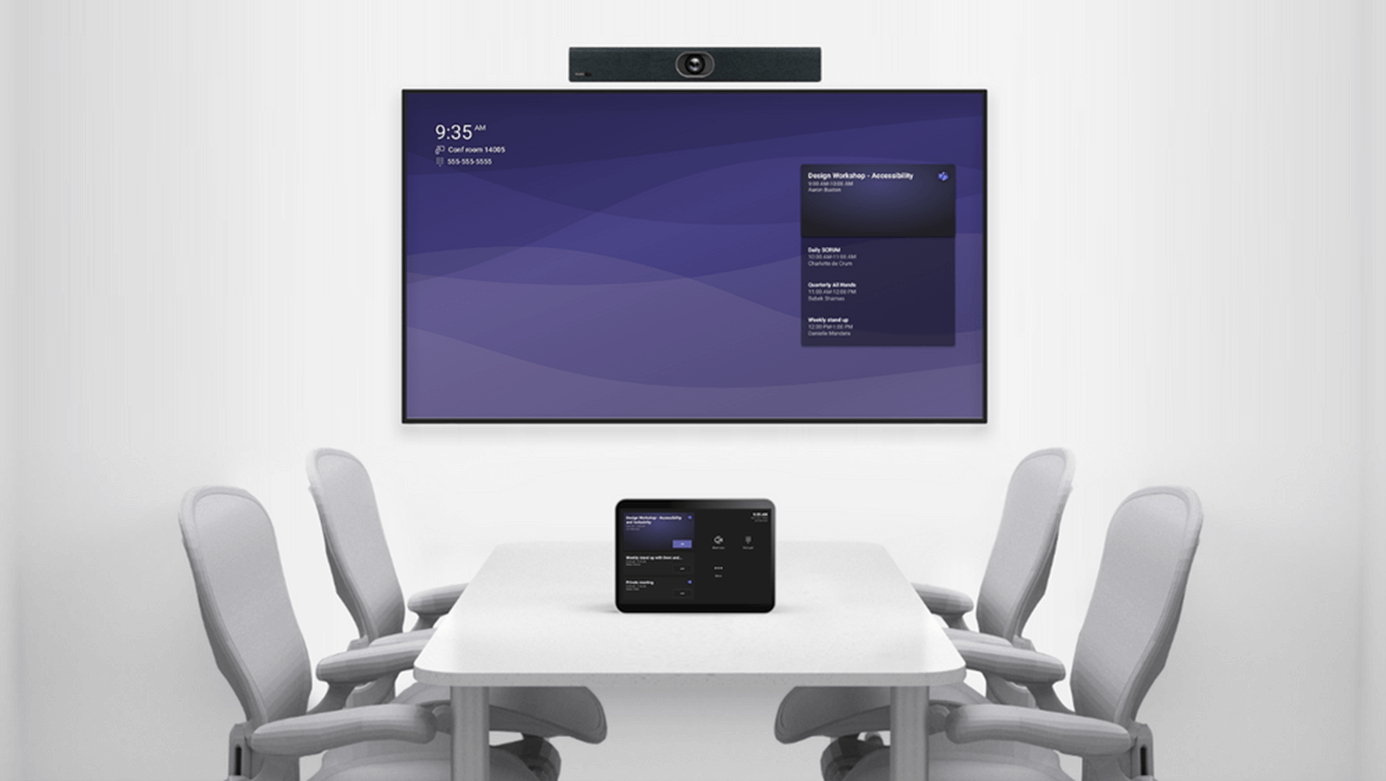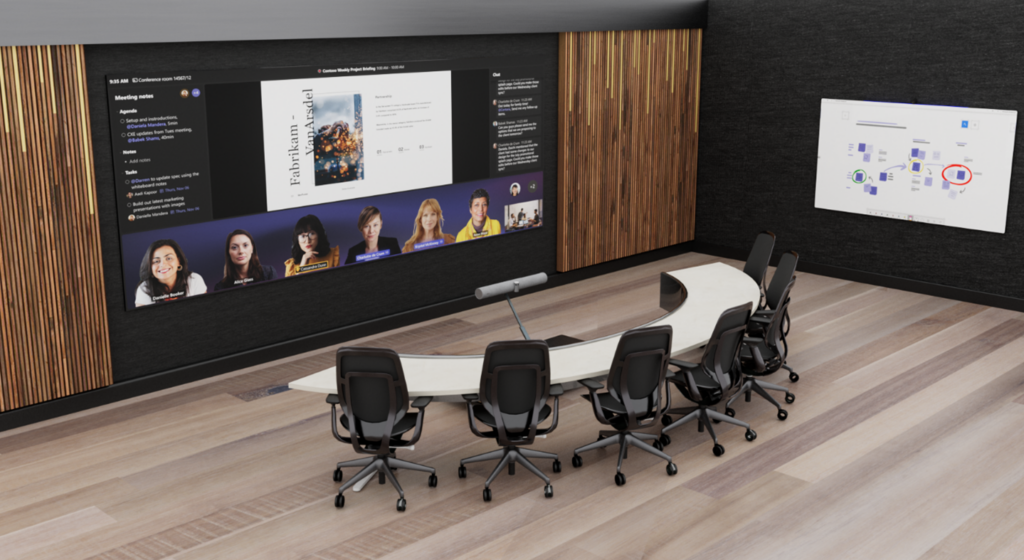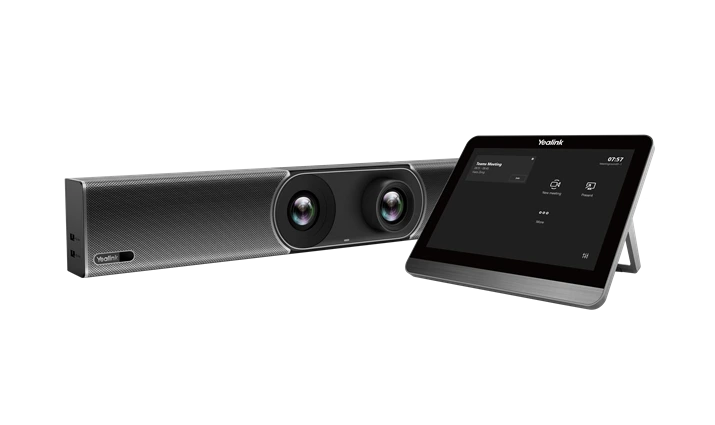In the ever-evolving landscape of remote work and virtual collaboration, Microsoft Teams has emerged as a powerful tool. But what exactly is a Microsoft Teams Room? In this article, we will delve into the concept, components, setup process, effective utilisation, and the future of Microsoft Teams Rooms.

Contents
What is a Microsoft Teams Room?
A Microsoft Teams Room is a purpose-built and integrated solution that transforms any space into a collaborative meeting environment. By combining high-quality audio and video capabilities with seamless integration to the Microsoft Teams platform, Teams Rooms enable individuals and teams to connect, communicate, and collaborate effectively, no matter their physical location. A Microsoft Teams Room is a revolutionary solution designed to transform any ordinary meeting space into a smart and collaborative environment.
So, whether you’re hosting a brainstorming session, conducting a virtual client meeting, or even teaching a virtual class, Microsoft Teams Rooms provides you with the ultimate audio and visual experience.
What is the purpose of a Microsoft Teams Room?
The primary goal of a Microsoft Teams Room is to facilitate seamless and productive communication and collaboration. It provides a dedicated space where participants can join meetings, share content, and interact in real-time, thereby enhancing teamwork and fostering better decision-making. Additionally, Teams Rooms offer several advantages, including improved meeting efficiency, reduced travel expenses, and increased inclusivity for remote team members.
One of the primary purposes of a Teams Room is to enhance collaboration among team members. With the ability to share content in real-time, participants can easily present their ideas, share documents, and collaborate on projects. This promotes active engagement and enables teams to work together more efficiently, regardless of their physical proximity.
Furthermore, Teams Rooms promote inclusivity by providing a platform for remote team members to actively participate in meetings. Through the use of video conferencing and screen sharing, individuals can join discussions, contribute their insights, and stay connected with the rest of the team. This fosters a sense of belonging and ensures that everyone’s voice is heard, regardless of their location.
What are the benefits of Microsoft Teams Rooms?
Microsoft Teams Rooms offer numerous benefits that can greatly enhance your meeting experience. Firstly, they provide a unified and integrated collaboration platform that allows teams to work together effectively, regardless of their physical location. Video conferencing, screen sharing, and real-time collaboration tools enable seamless communication and decision-making. Additionally, Teams Rooms offer high-quality audio and video capabilities, ensuring clear and immersive communication. The ease of use and intuitive interface further enhances productivity and efficiency. With Microsoft Teams Rooms, you can truly transform ordinary meetings into extraordinary experiences.
Let’s delve deeper into the concept of a Microsoft Teams Room and explore its features and functionalities. One of the key aspects of a Teams Room is its ability to transform any space into a collaborative meeting environment. Whether it’s a small huddle room, a large conference room, or even a classroom, Teams Rooms can adapt to various settings and accommodate different group sizes.
Teams Rooms are equipped with high-quality audio and video capabilities, ensuring that participants can hear and see each other clearly during meetings. This is essential for effective communication, especially when team members are located in different geographical locations. The seamless integration with the Microsoft Teams platform further enhances the experience by providing a familiar interface for participants to join meetings, access shared content, and engage in discussions.
Moreover, Teams Rooms offer a range of additional features that further facilitate collaboration. For example, participants can use digital whiteboards to brainstorm ideas, annotate documents, and visualise concepts. This interactive element adds a dynamic and engaging dimension to meetings, encouraging creativity and innovation.
Another significant benefit of Teams Rooms is the potential cost savings they offer. By eliminating the need for extensive travel, teams can conduct meetings remotely, reducing travel expenses and saving valuable time. This is particularly beneficial for organisations with geographically dispersed teams or clients, as it enables them to connect and collaborate without the constraints of physical distance.
Is any meeting space suitable for Microsoft Teams Rooms?
Yes, absolutely! Microsoft Teams Rooms can be set up in a variety of meeting spaces, ranging from small huddle rooms to large conference rooms. Whether you’re in a corporate office, a co-working space, or even your home office, Microsoft Teams Rooms offers flexibility and adaptability to meet your needs. So, no matter the size or layout of your meeting space, there’s a Teams Room solution for you.
How much does a Microsoft Teams Room cost?
The cost of a Microsoft Teams Room varies depending on the specific requirements of your meeting space. Factors such as room size, audio needs, and video display preferences can influence the overall cost. However, Microsoft offers a range of options to suit different budgets, ensuring that there’s a Teams Room solution for businesses of all sizes. To get an accurate estimate, it’s best to consult with an authorised Microsoft partner like TenAV who can provide a tailored quote based on your specific needs.
What is the difference between Microsoft Teams and Microsoft Teams Rooms?
The main difference between Microsoft Teams and Microsoft Teams Rooms lies in their scope and functionality. Microsoft Teams is a collaborative communication platform that enables individuals and teams to chat, meet, and collaborate from anywhere, on any device. It allows for instant messaging, file sharing, video conferencing, and much more. On the other hand, Microsoft Teams Rooms focuses specifically on enhancing the meeting experience in physical spaces by providing integrated audio and video solutions. It ensures that meetings are seamless, productive, and efficient, whether participants are in the room or joining remotely.
Do I need a licence for Microsoft Teams Rooms?
Yes, a Microsoft Teams Rooms licence is required to use the full range of features and functionality. You will need to obtain the appropriate licence for each room where you plan to deploy a Teams Room solution. Microsoft offers different licensing options to accommodate various business needs, so you can choose the licence that best suits your requirements. It’s always a good idea to consult with a Microsoft partner like TenAV who can guide you through the licensing process and help you select the right licence for your organisation.
Are there any other uses for Microsoft Teams Rooms?
Absolutely! While Microsoft Teams Rooms are designed primarily for enhancing the meeting experience, they can be used for various other purposes. For example, they can serve as convenient collaboration spaces for brainstorming sessions, training sessions, or even virtual classrooms. With the advanced audio and visual capabilities of Microsoft Teams Rooms, you can engage, interact, and share ideas seamlessly, regardless of your physical location.

What are Signature Microsoft Teams Rooms?
Signature Microsoft Teams Rooms take the meeting experience to a whole new level. These cutting-edge solutions offer enhanced audio and video capabilities, tailor-made for high-impact meetings. With top-of-the-line camera technology, crystal-clear audio, and large, high-resolution displays, Signature Teams Rooms provide an immersive and engaging meeting environment. Whether you’re presenting to a large audience or conducting a high-stakes negotiation, Signature Teams Rooms ensure that every participant feels fully connected and involved.
What is front row?
Front row is a unique feature of Microsoft Teams Rooms that brings every meeting participant closer together, regardless of their physical location. With front row, the camera automatically frames and zooms in on the active speaker, ensuring that everyone can see and hear clearly. This feature eliminates the need for manual camera adjustments and enhances the meeting experience by providing a clear view of the presenter. So, whether you’re sitting in the front row or joining remotely, front row ensures that you never miss a detail. Partnering with a 21:9 ratio screen can be a very powerful combination.
What is the Microsoft Teams whiteboard feature?
The Microsoft Teams whiteboard feature is a powerful tool for visual collaboration and brainstorming during meetings. It allows participants to create, share, and collaborate on a virtual canvas in real-time. With the whiteboard feature, you can draw, write, and add sticky notes, bringing your ideas to life. Whether you’re brainstorming ideas, mapping out a project plan, or visualizing data, the whiteboard feature in Microsoft Teams Rooms provides a dynamic and interactive platform for creativity and collaboration.
Who can install a Microsoft Teams Room?
To ensure a successful installation and setup of a Microsoft Teams Room, it’s recommended to have a certified Microsoft partner or an experienced IT professional handle the installation process. They have the expertise and knowledge to deploy the necessary hardware, configure the software, and ensure seamless integration with your existing IT infrastructure. They can also provide training and support to ensure that you make the most out of your Teams Room investment.
Is this solution suitable for use in a home office?
Yes, Microsoft Teams Rooms can be a great addition to your home office setup. Whether you’re hosting virtual client meetings, collaborating with remote colleagues, or even attending virtual conferences, Teams Rooms can provide you with a professional and immersive meeting experience right from the comfort of your own home. With its advanced audio and visual capabilities, as well as seamless integration with Microsoft Teams, you can stay connected and productive, no matter where you’re working from.
Can a meeting room booking panel be used with Microsoft Teams Rooms?
Yes, absolutely! A meeting room booking panel is a valuable addition to a Microsoft Teams Room setup. It allows users to easily schedule and manage meeting room availability directly from the panel. By integrating the booking panel with Microsoft Outlook or other scheduling platforms, it provides a convenient way to book, check availability, and manage meeting room resources. This ensures that your Teams Rooms are efficiently utilised and eliminates any scheduling conflicts or confusion.
Are Microsoft Teams Rooms available in all countries and territories?
Yes, Microsoft Teams Rooms are available for deployment in most countries and territories. Microsoft is committed to making Teams Rooms accessible to businesses worldwide, enabling them to benefit from this advanced collaboration solution. However, it’s important to note that certain regional factors, including local regulations and availability of Microsoft-certified partners, may affect the deployment and support of Teams Rooms in specific locations. It’s best to consult with a Microsoft partner to confirm the availability and support options in your country or region.
Can I set up a Microsoft Teams Room on a video wall?
Absolutely! Microsoft Teams Rooms can be set up on a video wall, providing a stunning and immersive meeting experience. With a video wall setup, you can display high-quality video from multiple participants, share documents or presentations, and collaborate in real-time. Whether you’re planning a large-scale conference or a high-visibility presentation, a video wall setup with Microsoft Teams Rooms can make a lasting impression and enhance engagement.
How do I buy a Microsoft Teams Room?
To purchase a Microsoft Teams Room, it’s best to consult with a certified Microsoft partner and AV integrator like TenAV who can guide you through the procurement process. They can help you assess your specific requirements, recommend the appropriate hardware and licensing options, and provide you with a customised quote based on your needs. Microsoft partners also offer installation, training, and ongoing support to ensure a smooth deployment and optimal usage of your Teams Room solution. So, reach out to a Microsoft partner today and take your meeting experience to the next level!
What hardware is essential for Microsoft Teams Room?
While the specific hardware requirements may vary depending on the size and needs of your meeting space, there are a few key components that are essential for a Microsoft Teams Room setup. These include a high-quality camera, a microphone array for clear audio capture, a speaker system for crisp sound playback, and a high-resolution display for optimal viewing. Additionally, a dedicated computer or a Teams-certified device is required to run the Teams Room software. It’s crucial to choose reliable and compatible hardware to ensure a smooth and productive meeting experience.
The components of a Microsoft Teams Room
Hardware requirements for a Microsoft Teams Room
A successful Teams Room setup relies on a combination of hardware components. These typically include a high-definition camera, high-quality microphones and speakers, a display device, and a dedicated Teams Room console. These components work together to provide an immersive meeting experience with crisp audio, clear video, and easy meeting control.
Software requirements for a Microsoft Teams Room
In addition to the hardware, a Microsoft Teams Room requires the appropriate software configuration. This includes the Microsoft Teams app and the Teams Room console software, which enable participants to join and manage meetings, access shared content, and utilise various collaboration features.
When it comes to creating a Microsoft Teams Room, it’s important to understand the various components that make up this innovative meeting solution. Let’s take a closer look at the hardware and software requirements in more detail.


Hardware Requirements
A Microsoft Teams Room is equipped with a range of hardware components that work together seamlessly to deliver a top-notch meeting experience. One of the key hardware requirements is a high-definition camera. This camera captures high-quality video, ensuring that participants can see each other clearly during meetings. Whether it’s a small huddle room or a large conference room, the camera plays a vital role in creating a sense of presence.
In addition to the camera, high-quality microphones and speakers are essential for crystal-clear audio. These components ensure that participants can hear each other with precision, eliminating any communication barriers. The audio quality is crucial for effective collaboration, as it allows everyone to actively participate in the discussion without missing any important details.
Another important hardware requirement is a display device. This can be a large TV or an LED wall, depending on the size of the room. The display device enables participants to view shared content, presentations, and documents with ease. It enhances the overall meeting experience by providing a clear and vibrant visual representation of the content being discussed.
Lastly, a dedicated Teams Room console panel is an integral part of the setup. This console acts as the control centre for the Teams Room, allowing participants to easily manage meetings, control audio and video settings, and access various collaboration features. With a user-friendly interface, the console simplifies the meeting experience and ensures smooth operation.
Software Requirements
While the hardware components are essential, the software configuration is equally important for a Microsoft Teams Room to function optimally. The primary software requirement is the Microsoft Teams app, which serves as the central hub for all communication and collaboration activities. This app enables participants to join meetings, chat with colleagues, share files, and collaborate in real-time.
In addition to the Teams app, the Teams Room console software is crucial for managing the room effectively. This software provides a dedicated interface on the console, allowing participants to easily navigate through meeting controls, access shared content, and utilise collaboration features such as whiteboarding and screen sharing. The console software enhances the overall user experience by providing a seamless and intuitive interface.
Furthermore, it’s important to ensure that the software is up to date with the latest security patches and feature enhancements. Regular updates help in maintaining a secure and reliable meeting environment, ensuring that participants can collaborate without any interruptions or vulnerabilities.
Should I choose Microsoft Teams Rooms or Zoom Rooms?
The choice between Microsoft Teams Rooms and Zoom Rooms depends on your specific requirements and preferences. Both solutions offer similar features and functionality for enhancing the meeting experience. Microsoft Teams Rooms provide seamless integration with the Microsoft ecosystem, allowing for easy collaboration, file sharing, and access to other Microsoft apps and services. On the other hand, Zoom Rooms offer a user-friendly interface with a focus on video conferencing capabilities. It’s important to consider your organisation’s existing infrastructure, collaboration needs, and user preferences when deciding between the two.
In conclusion, a Microsoft Teams Room offers a comprehensive solution for effective remote collaboration. By understanding the concept, components, setup process, best practices, and future developments, you can make the most of this innovative platform and create a seamless and productive virtual meeting environment.

